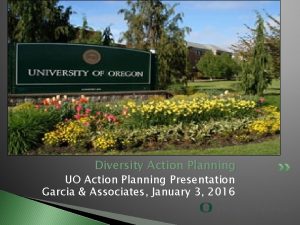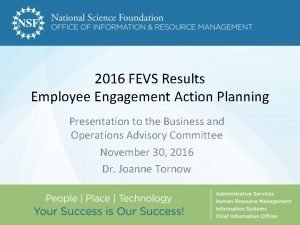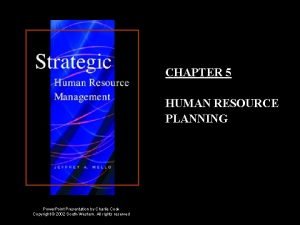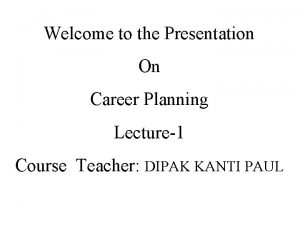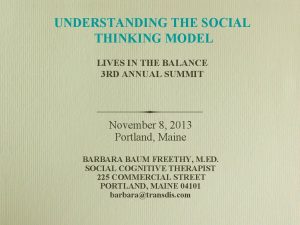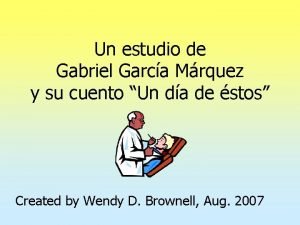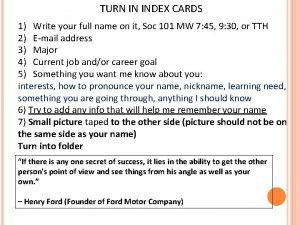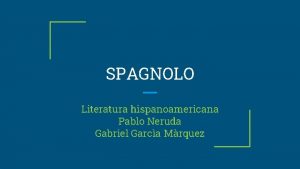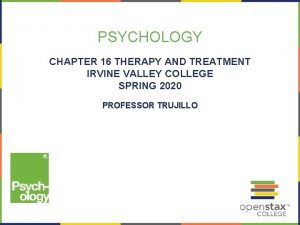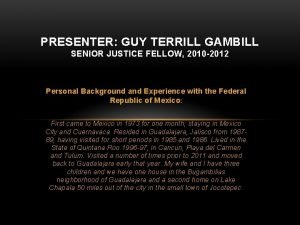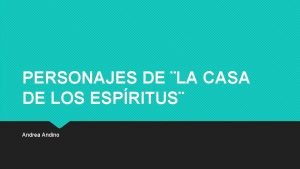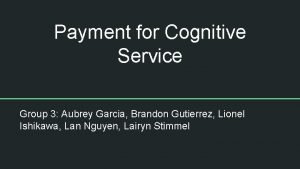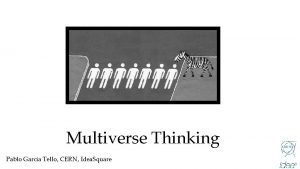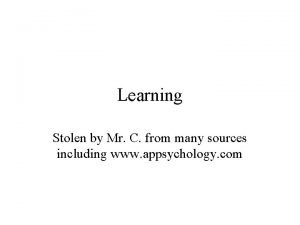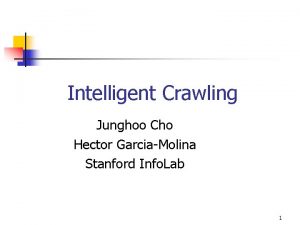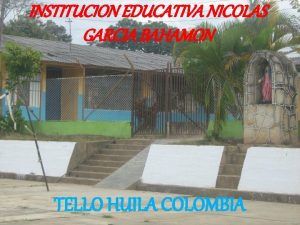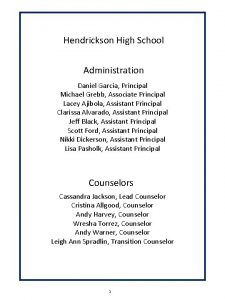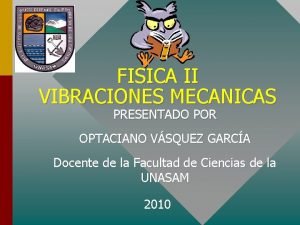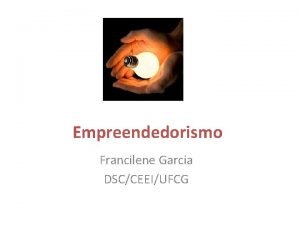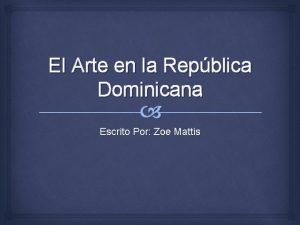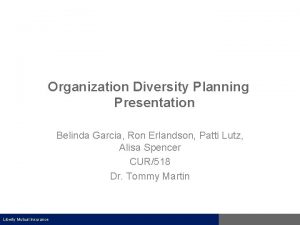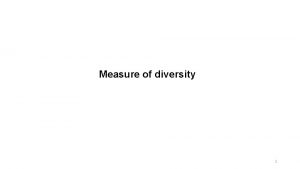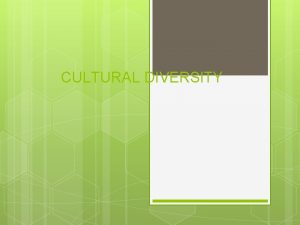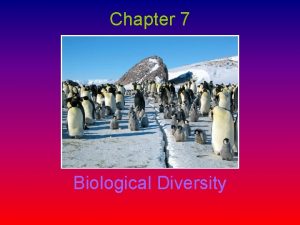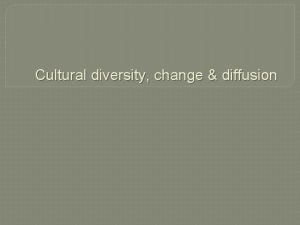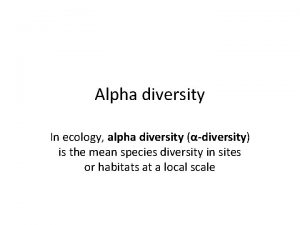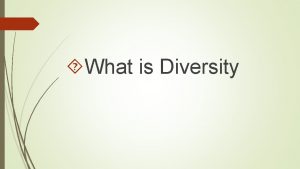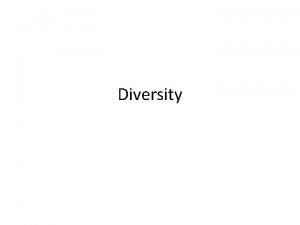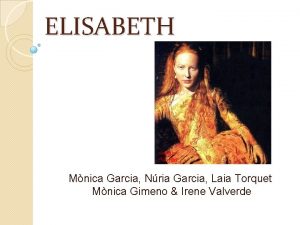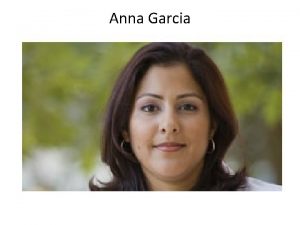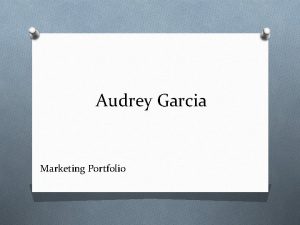Diversity Action Planning UO Action Planning Presentation Garcia


































- Slides: 34

Diversity Action Planning UO Action Planning Presentation Garcia & Associates, January 3, 2016

Meeting Agenda Ø Introductory Remarks: President Michael Schill Ø Overview of Planning Process & Introduction of Workshop Presenters: VP Alex-Assensoh Ø Best Practices in Action Planning Ø Table Top Exercise 1: Building Common Ground Ø Diversity, Equity and Inclusion at the UO: Themes from Leadership Ø Table Top Exercise 2: Building A New Reality Ø Tools to Get us Started on Diversity Action Planning Ø Table Top Exercise 3: Designing Tactics and Measures for your unit Ø Questions, Observations, and Needs Ø Next Steps

Diversity, Equity & Inclusion Are Not… Ø Quick fixes Ø Confrontational Ø About changing you Ø Problems Ø Just fads Are… Ø A Beginning Ø Introspective Ø Thought Provoking Ø An opportunity for short and long term success Ø A Journey and NOT a Destination

Required Tools to Inform Your Diversity Action Planning Ø Ø Ø Mission Vision Values Frameworks: President’s Priorities & IDEAL UO Diversity Action Plan Template Data Stats, Trends, and Other Data Points Evaluation: Benchmarking and Metrics SWOT Analysis Division of Equity & Inclusion (DEI) Office & Website Office of Affirmative Action and Equal Opportunity Office of Institutional Research

Leadership, Vision and Support Ø To create a successful unit action plan, the UO leadership must endorse, integrate, and support an inclusive culture by leading, setting the vision, and providing support. Ø Each leader must ensure his/her plan is designed to make change in the identified priorities (i. e. , adapt/develop/ implement policies, practices, services, and activities etc. , ) Ø Cultural transformation requires leadership, commitment, human and fiscal resources, sustainability, and patience. Ø Diversity, Equity, and Inclusion support should permeate throughout the University with your guidance.

Finding Common Ground Respect Ø The Golden Rule states we should treat people the way we would want to be treated. Respect is demonstrated by acknowledging and valuing the unique qualities and differences of individuals. Connection (Individual vs. Team): Ø Ø A group of people may work in the same unit but they work independently, without interaction or reliance on each other. Individuals in the group are focused on achieving their own goals, and the goals of the organization are secondary. A team, on the other hand, is a group of individuals with common goals and tactics. They can help each other, by working together toward the accomplishment of a set goal. When people feel connected they can turn into a cohesive team striving towards the same goal. Intentional and inclusive communication can create an environment where everyone feels included, supported and capable of contributing to the team.

Table Top Exercise: Finding Common Ground Activity Ø Ø What did you discover from this group activity? What surprised you? Is this an activity/tool you could use with constituents in your unit? Conclusion : Finding Common Ground is key to connectivity, leading and inclusion. It can also help reduce biases and conflict.

Qualitative Interviews Individual and Group Interviews with Consultants Ø Confidential Conversations about perceived strengths and weaknesses Ø Insight and Direction Ø Highlights of Selected Major Themes as follows: Ø

Key Informant Themes Through IDEAL Framework Lens � Inclusion Strategy ◦ “Students, faculty, staff, and administrators deserve a positive, equitable, and inclusive environment in which they can live, work, learn, and teach. The University of Oregon needs to be a welcoming, supportive and respectful community for all. ” STRENGTHS WEAKNESS Forums for dialogue across campus Campus homogeneity (very White): Lack of cultural agility and competency. Implicit Bias Training Some units are dominated by male culture Guest Speaker Lunches Isolating & threating environments are perceived to exist by women & racial/ethnic minorities Diversity Committees

Key Informant Themes Through IDEAL Framework Lens � Diversity Strategy “The term “diversity” can be defined in a number of different ways. The UO looks at it broadly and inclusively, encompassing race, ethnicity, disability, thought, culture, religion, sexual orientation, gender, and economics. The UO seeks to promote further diversity among its faculty, staff, and student body through active recruitment and intentional retention. ” STRENGTHS WEAKNESS Diversity Committees Reputation - lack of diversity Bridge/Pipeline Efforts No Diversity Policies Blind Screens in Hiring Understanding of Diversity, Equity & Inclusion Faculty In Residence & Recruitment Perception that Minority Programs Faculty trend is downward DEI Programs & Services Revolving door where faculty come and don’t stay

Key Informant Themes Through IDEAL Framework Lens � Achievement Strategy ◦ “The UO is committed to achievement and success for all of its students, faculty, staff, and alumni. All students—no matter what their background— deserve to succeed and graduate in a timely manner from the institution. All faculty—regardless of race, religion, ethnicity, sexual preference, ideas, or physical ability—deserve the resources and encouragement to flourish. All staff similarly must be given tools to succeed at their jobs and advance their careers. The UO is also committed to the ongoing success of all of its alumni. ” STRENGTHS WEAKNESS Minority Student Enrollment & Graduation Trend line Minority Faculty Trend line Mentorship Programs Climate for Minority Students Professional Development Climate for Women & Grants Ethnic/Racial Minorities

Key Informant Themes Through IDEAL Framework Lens � Evaluation Strategy ◦ “Research universities produce and preserve knowledge, often relying on evidence, data, and robust analyses. The UO seeks to incorporate unbiased evaluations of the implementation of strategies and initiatives employed to meet institutional goals relating to diversity, equity and inclusion. The UO seeks to establish key metrics and reporting structures necessary to ensure accountability and an inclusive process of review. ” STRENGTHS WEAKNESS DEI Programs & Services Unaware of key metrics & reporting structures Office of Institutional Research: Many data points available Top national companies no longer recruit at the UO

Key Informant Themes Through IDEAL Framework Lens � Leadership Strategy ◦ “Diversity, equity, and inclusion must be part of the agenda of all leaders of the University of Oregon. From the president to department chairs, from the ASUO president to the president of the University Senate, all leaders need to promote the university’s values in both plans and action. The Division of Equity and Inclusion will play the central role on campus in promoting equity and inclusion; in supporting the efforts of leaders to achieve diversity, equity, and inclusion; and in tracking progress toward meeting those objectives. ” STRENGTHS WEAKNESS Recognition for increased clarity & operationalization through definitions, assessment, practice, metrics, accountability, and alignment with overarching mission & goals. No Diversity Policy & No Business Case; Lacking Accountability; “Check the Box Culture” IDEAL Framework Isolated; not integrated throughout campus climate & culture Increased Budget & Resource Allocation Trend line Understanding of Diversity, Equity & Inclusion Stronger voice needed from all units and administration

Qualitative Interviews Ø Ø Building New Reality Question? How do we collaborate as a team? As UO Leaders how can we find common ground to address theme findings? Ø What are your fears based on the findings? Ø What are some solutions you would recommend? Ø What type of actions can you take to enhance the positive and eliminate the negative?

Action Planning for Diversity, Equity and Inclusion (APDEI) Ø Action planning is a tool for organizing the desired outcomes. In this case, the Action Planning for Diversity, Equity, and Inclusion (APDEI) is a road map to lead your planning and outcomes. Your plan should align with the President’s Priorities and IDEAL. Ø The purpose of action planning is to align your unit’s work with the UO’s mission, values, priorities, and framework to support the identified goals and tactics.

Action Planning Framework The Action Planning document has a basic overall framework. Place all parts of a plan into the following three areas, you can clearly view how the pieces of your plan can fit together: � � � Where are we now? (Executive Summary) Review your current strategic position and clarify your unit’s mission, vision, and values. Where are we going? (Tactics and Measures) Establish your unit’s vision by using the President’s Priorities & IDEAL Framework. How will we get there? (Resources) Understand the available resources to connect where you are now to help get you where you’re going. Review institutional strategic objectives, goals, data points, action items, timelines, resources, etc.

Action Plan Development: Using the IDEAL Framework Ø STRUCTURE: The UO Diversity Action Template (APDEI) includes a general description of each goal, followed by quantifiable strategies and tactics. Leaders are to identify tactics, measures, resources, leads and a timeline over a 3 year period. For each tactic, specify the target group (students, faculty, staff, administrators, alumni, etc. ) Ø EVALUATION TOOLS AND METRICS: Units will identify appropriate evaluation tools per identified tactic. Incorporating both qualitative and quantitative metrics is encouraged. Ø REPORTING: Each mission/unit will submit a diversity Action Plan to the Vice President for Equity, and Inclusion by March 17, 2017. Plans will be posted on website and communicated throughout the UO.

Best Practices for Action Planning Ø Ø Ø Ø Pull together a diverse planning team: Bring together a core team — between six and ten people — of faculty, staff, students, and other stakeholders. Allow time for strategic thinking: Your team needs time to think Big. Set dates, times, and locations for group to meet. Get commitment from key individuals in your unit: You can’t do it alone. If your team doesn’t buy in to the planning process and your unit’s action plan won’t be as effective. Allow for open and free discussion regardless of each person’s position within the unit: Leaders must encourage active participation, diverse viewpoints, and discourage individuals from dominating the planning sessions. Make your plan actionable: To have any chance at implementation, the plan must clearly articulate goals, action steps, responsibilities, accountabilities, and specific deadlines. Use SMART Goals. Understanding what you plan: Your team must understand the plan, assigned roles, responsibilities and expectations. Clearly articulate next steps after every session. Before ending a action planning session, leaders must explain what comes next and who’s responsible and set deadlines. Review other examples: Find inspiration and ideas from the examples of plans.

SMART Tactics and Metrics Tactics Metrics S Specific Is the result or outcome clearly stated? Is the metric clear, easy to understand? M Measurable Can the result be measured? Are the data readily available? A Actionable Can the tactic be achieved? Can you influence a change in the result? R Relevant Does the tactic link to the strategy of the IDEAL framework? Does the metric measure what is important? T Timely Is the completion time of the tactic clearly identified? How often do you need the data?

Pitfalls to Avoid In Action Planning Ø Ø Ø Ignoring what your planning process reveals: The planning process includes research and analysis. Take it seriously. Use it to move forward. Being unrealistic about your ability to plan: Putting together a plan takes time and effort. Be realistic and schedule planning sessions. Work backwards on your timeline. Plans due March 17, 2017. Not a one person planning process: Planning must engage various stakeholders to ensure representation of different perspectives. The action planning process must engage individuals and team members to work together. Not a one person implementation process: Execution of the plan must involve various stakeholders to implement the plan within the unit. Identify as many multiple responsible parties. Need support or more direction? Reach out ASAP. Don’t wait until the last minute. Action planning takes time.

UO Diversity Action Plan Template � GOAL #1 (I: Inclusion): Create an inclusive and welcoming environment for all. ◦ School, College, Research or Administration Strategy 1 – Create a more welcoming, respectful and inclusive climate for all. Tactics Target Measures Resources to be Lead used for this tactic 1. 1 UO to develop and unveil a # of individuals/units who Time for UO development of diversity wall, chronicling participate in the Executive concept, participants significant events in UO’s development and Leadership and budget. history that advanced diversity implementation of the within the university's diversity wall. workforce. The wall will #Location of Wall highlight major diversity milestones at the UO. # of individuals who view Historical photos and wall Describe the evaluation tool that you will utilize to information will come from progress and ensure accountability. UO’s library and other sources. Timeline Year 1, Year 2, Year 3 Develop Concept, Identify Budget and Approval Year 1 Implementation of Project Year 2 measure Qualitative survey will be created to measure impact, success of diversity wall.

UO Diversity Action Plan Template � GOAL #2 (D: Diversity): Increase the representation of diverse students, faculty, staff and community partners at all levels of the university. ◦ School, College, Research or Administration Strategy 1 - Incorporate active recruitment strategies, implicit bias training and other promising practices to recruit diverse staff, faculty, administrators, undergraduate and graduate students from traditionally under-represented communities. Resources Tactics Target Measures Lead 1. 1 Create a Diversity, Equity & Inclusion Component for Employee Onboarding “Orientation Program”. Program to allow new hires to learn of role and expectations of diversity at the UO. Time for development of HR Unit % of individuals who participate in program concept, participants and Leader % of new hires who budget. understand role of diversity at UO % of new hires that are retained on annual basis Timeline Year 1, Year 2, Year 3 Develop & Implement Plan in Year 1 Describe the evaluation tool that you will utilize to measure progress and ensure accountability. Hiring Numbers, Retention Trends, and Campus Climate Survey

UO Diversity Action Plan Template � GOAL #4 (L: Leadership): Leadership will prioritize and incorporate diversity, equity and inclusion in plans and actions. ◦ School, College, Research or Administrative Strategy - Develop and promote programs that mentor and prepare members of underrepresented groups for leadership opportunities (i. e. department heads, directorships, deanships, vice presidencies, etc. ) at the UO. Tactics Target Measures 1. 1 Formalize & Implement a # of participants that Leadership Program for URM complete program Faculty and Staff; in preparation # of participants that for leadership positions. are promoted Resources Lead Time/Staff for Unit Leader departments to develop program and measurement tools. Additional funding. Timeline Year 1, Year 2, Year 3 Program developed and approved in Year 1. Program implemented in Year 2. Describe the evaluation tool that you will utilize to measure progress and ensure accountability. Questionnaire to measure program effectiveness and participant leadership development.

Table Top Exercise: Group Activity (2) Ø Ø Review DEI template Goal #3 (A: Achievement) Collectively address how your unit would eradicate the Student Achievement Gap Complete Template (Tactics, Target Measures, Resources, Lead and Timeline) Group Discussion

UO Diversity Action Plan Template � GOAL #3 (A: Achievement): Facilitate access to achievement, success and recognition for underrepresented students, faculty, staff and alumni. ◦ School, College, Research and Administration Strategy 1 - Eradicate any existing gaps in achievement between majority and under-represented students, faculty and staff in graduation rates, tenure and promotion, professional opportunities, leadership opportunities and recognition. Tactics 1. 1 Target Measures Resources Lead Timeline Year 1, Year 2, Year 3 Describe the evaluation tool that you will utilize to measure progress and ensure accountability.

Consultation & Resources Ø The Division of Equity, Inclusion and Diversity will provide coordination and work with units to develop individualized goals and appropriate metrics, as well as to analyze resources, assess timelines, measure success and advise localized leadership. Ø The DEI Website will host all submitted Diversity Action Plans to inform UO Community of progress of planning. Ø The DEI Website will also advertise workshops and other trainings to support their action planning. Ø Garcia & Associates will also provide consultation to unit leaders and teams and guide in action planning to the UO via the Vice President for Diversity, Equity, and Inclusion.

Diversity Action Planning Timeline January - 2017 Ø PHASE 1 - PREPARE FOR ACTION PLANNING Preliminary Planning: Ø Ø Ø Ø Ø Activity 1: 2: 3: 4: Identify and Invite Team Members Charge Team, Provide Direction and Resources for Action Planning Unite Teams, Set Meeting Dates and Times Seek Resources, Information, and Support, if required PHASE 2 – DEVELOP THREE-YEAR ACTION PLAN Preliminary Planning Activity 1: Activity 2: Activity 3: Template. Activity 4: Activity 5: Review Data Points, Tools, Resource and Template Requirements Unit Environmental Assessment (Mission, Vision, Values) Begin Drafting Tactics as inscribed by the UO Diversity Action Plan Use Guiding Questions to assist your thoughts. Seek Resources, Information and Support, if required Plan for 2 -3 Drafts of your unit’s Action Plan

Diversity Action Planning Timeline February, 2017 Ø Ø Ø Ø PHASE 3 - FINALIZE PLAN Review Process Activity 1: Team Members to Review, Edit and Modify Draft/s Activity 2: Seek Resources, Information, and Support, if required Activity 3 Make Final Review and Edits to Action Plan Activity 4: Ensure all Set Requirements (Executive Summary, Goals and Tactics) are addressed Activity 5: Circulate Draft with Team Members for modifications prior to final submission. Ensure all team members understand their role, responsibilities, and expectations as outlined in your unit’s plan. Activity 6: Seek Resources, Information and Support, if required

Diversity Action Planning Timeline March, 2017 PHASE 4 - SUBMIT PLAN Submission of Plan Ø Activity 1: Send Electronic plans to vpinclusion@uoregon. edu no later than March 17, 2017 Ø Activity 2: The President, Provost and Vice President of Equity & Inclusion will review your final plan and contact unit leaders should there be any questions on the submission. Ø Ø Ø PHASE 5 - SHARE PLAN Communication of Plan Activity 1: The Division for Equity & Inclusion (DEI) will post plans on appropriate websites Activity 2: The University Communications will communicate to the UO Community of the accomplished work via different vehicles of communication.

Q&A

Go DUCKS!

DEI Resources � � � Diversity at the UO https: //inclusion. uoregon. edu/content/diversity-uo Faculty & Staff http: //inclusion. uoregon. edu/content/coaching-faculty-staff ◦ Strategy Work Groups ◦ Professional Development Co. Da. C Faculty Development http: //inclusion. uoregon. edu/content/faculty-development ◦ Faculty Equity Statements for Tenure, Promotion and Review ◦ Faculty Writing Center ◦ National Center for Faculty Development & Diversity ◦ UO Faculty Development Resources

DEI Resources � � Co. Da. C Faculty In Residence https: //inclusion. uoregon. edu/content/faculty-residence Co. Da. C Equity Initiatives https: //inclusion. uoregon. edu/content/equity-initiatives Faculty Hiring http: //academicaffairs. uoregon. edu/recruitment-retention http: //facultyhiring. uoregon. edu/ Faculty & Staff Demographics https: //inclusion. uoregon. edu/facts-and-figures http: //ir. uoregon. edu/personnel

DEI Resources � Office of Affirmative Action and Equal Opportunity ◦ http: //aaeo. uoregon. edu/ ◦ 541 -346 -3123 � Office of Institutional Research ◦ http: //ir. uoregon. edu/ � Association of American Universities ◦ http: //www. aau. edu/home. aspx � American Council on Education ◦ http: //www. acenet. edu/Pages/default. aspx � Society for Human Resource Management (SHRM) Diversity & Inclusion ◦ https: //www. shrm. org/resourcesandtools/hrtopics/pages/diversity-and-inclusion. aspx
 What is ecosystem biodiversity
What is ecosystem biodiversity Genetic diversity vs species diversity
Genetic diversity vs species diversity Diversity action plan template
Diversity action plan template Fetal lie
Fetal lie Cephalic presentation
Cephalic presentation Employee engagement survey results and action plan ppt
Employee engagement survey results and action plan ppt Human resource planning powerpoint presentation
Human resource planning powerpoint presentation Career plan presentation example
Career plan presentation example Federico garcia lorca dibujo animado
Federico garcia lorca dibujo animado Double interview michelle garcia winner
Double interview michelle garcia winner Resumen dela biografia de gabriel garcia marquez
Resumen dela biografia de gabriel garcia marquez Jonathan eluterio martinez garcia
Jonathan eluterio martinez garcia Pablo neruda gabriel garcia marquez
Pablo neruda gabriel garcia marquez Diarrea coleretica
Diarrea coleretica Garcia effect
Garcia effect Gabriel garcia marquez considera a la entrevista como
Gabriel garcia marquez considera a la entrevista como óscar osvaldo garcía montoya
óscar osvaldo garcía montoya Pedro segundo garcia
Pedro segundo garcia Aubrey garcia
Aubrey garcia Hector garcia-molina junghoo cho
Hector garcia-molina junghoo cho Pablo garcia tello
Pablo garcia tello Clavos garcia 2000 años de garantia
Clavos garcia 2000 años de garantia Lluvia mansa y serena
Lluvia mansa y serena Claudine garcia debanc
Claudine garcia debanc Is playing bingo a variable ratio
Is playing bingo a variable ratio Macarena garcia marin
Macarena garcia marin Hector garcia-molina junghoo cho
Hector garcia-molina junghoo cho Maria lucia bueno garcia
Maria lucia bueno garcia Institucion educativa nicolas garcia bahamon
Institucion educativa nicolas garcia bahamon Daniel garcia hendrickson high school
Daniel garcia hendrickson high school Optaciano vasquez garcia fisica ii
Optaciano vasquez garcia fisica ii Dra aline garcia arteaga
Dra aline garcia arteaga Francilene garcia
Francilene garcia Enrique garcia godoy pinturas
Enrique garcia godoy pinturas Marc sagrista garcia
Marc sagrista garcia


